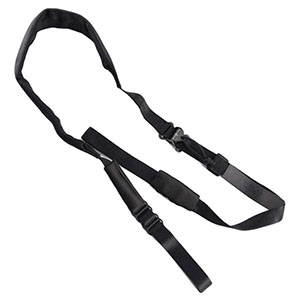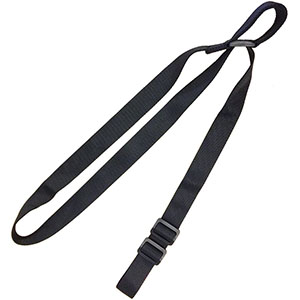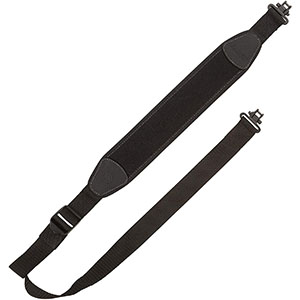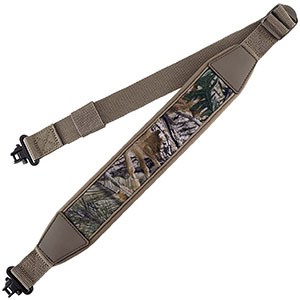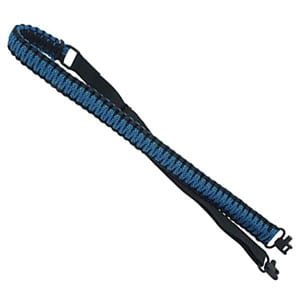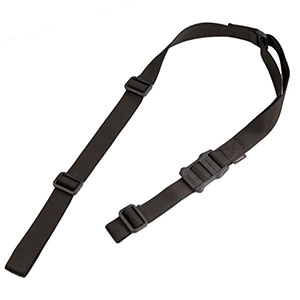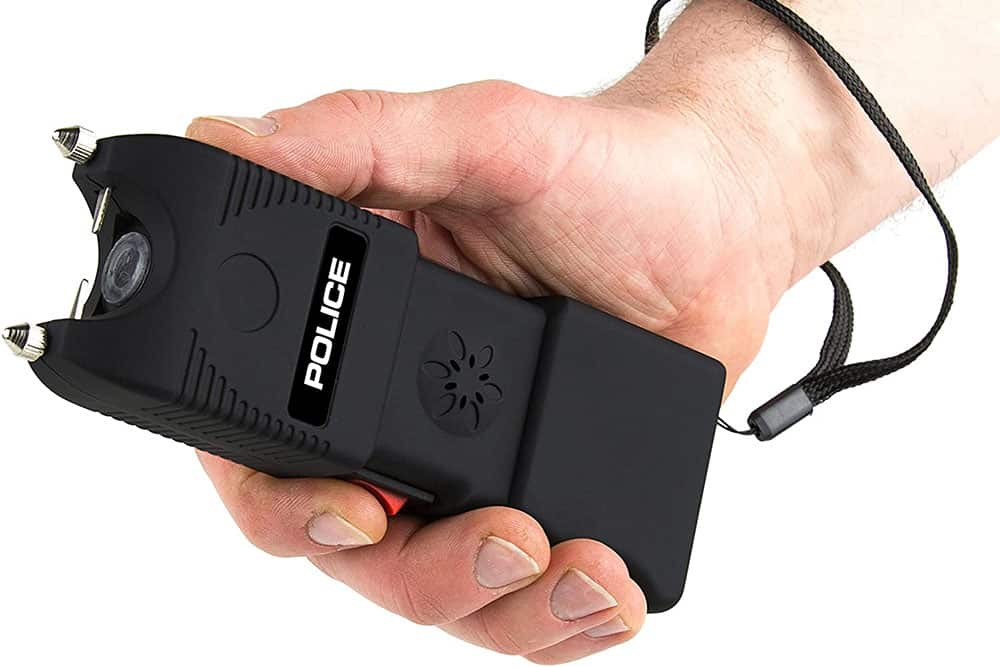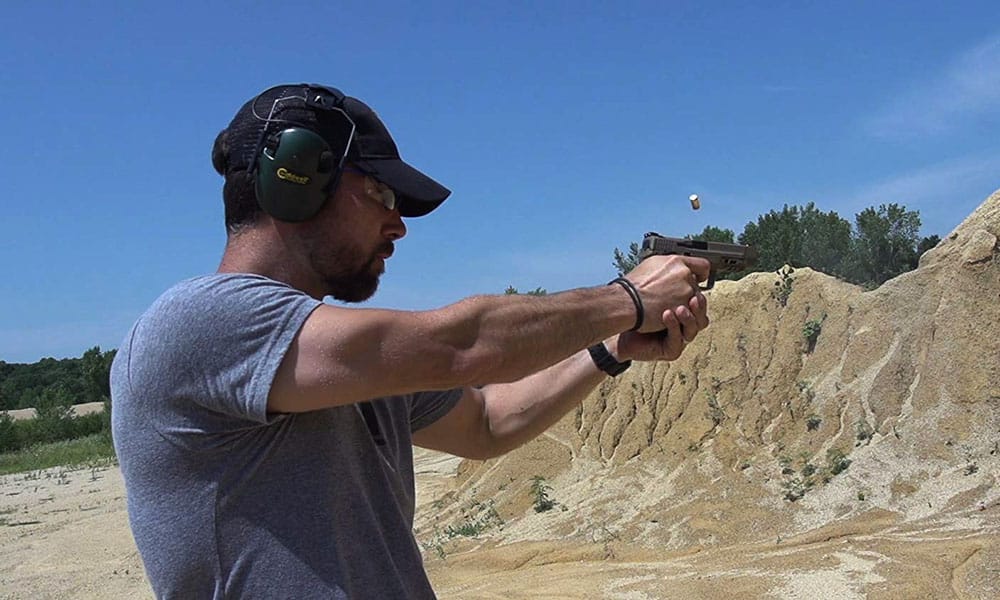Whether you’re spending a week in the backcountry tracking elk or you’re just out for a weekend deer hunt, your rifle sling is important. Choose a good one and you’ll barely notice the rifle is there as you hike. Choose a poor one and you’ll constantly be adjusting your firearm to try and find a comfortable position.
You could, of course, just carry your rifle the whole time, but that will get tiring really quick. And besides, you’re not trudging the dusty, sniper infested backroads of Chaparhar Province, you’re hunting. It’s supposed to be fun.
Below we’re going to take a look at the best rifle slings on the market today. If the time has come to replace your sling, take a few minutes and peruse our list before you buy anything.
1: Viking Tactics Wide Padded Sling
2: Sear Tactical Innovations Rifle Sling
The webbing is tube woven as opposed to flat woven with robust stitching throughout and a high impact polymer sling buckle. The STI 2-Point sling adjusts quickly and easily and is chafe-resistant, which is a good thing considering the total lack of padding. It adjusts out to a 55 inches, which will be plenty for the average guy, and you can adjust it on the fly, meaning you don’t have to detach it from the rifle to tweak the length. If you’re looking for a simple, dependable, affordable rifle sling with a 100% satisfaction guarantee, look no further than the STI 2-Point Rifle Sling.
3: Allen Cascade Neoprene Rifle Sling
It’s tested to 300 pounds and features sturdy swivels that aid in rapid deployment. It’s easy to attach and detach, and adjusts quickly and dependably. And maybe best of all it’s not going to slice up your shoulder if you have your rifle slung all day long. No doubt something fashioned from high quality nylon will last longer, but there’s no way it’s going to be as comfortable as the Allen Cascade Neoprene Rifle Sling.
4: CVLife 2 Point Sling
That said the CVLife 2-Point Sling is actually something of a hybrid because it also features elasticized cord at both ends to make long-haul carrying and rapid deployment a bit easier, and it features newly upgraded rustproof metal swivels, spring hooks and sling mount. And while some might recoil at metal components, thinking they clang around and scare off game, the 2-point sling is actually whisper quiet. Overall, a great choice for ARs or traditional hunting rifles.
5: Boosteady 2-Point Rifle Sling
The Boosteady 2-Point Rifle Sling is a good example of the difference even a little bit of padding makes to the rifle sling experience. The padding here is not exactly robust, but it’s enough to recommend this sling for all-day use. Beyond the shoulder padding the Boosteady boasts 22 – 45 inch adjustability, durable corrosion-resistant metal swivels, heavy duty stitching in all the major stress points, chafe resistant nylon webbing at the extremities and a generally attractive look, should such a thing carry any weight (so to speak) with you.
6: Raiseek Buffalo Hide Leather Rifle Gun Sling
On the upside it looks great, has corrosion resistant metal fasteners and mil-spec swivels that pave the way for a comfortable ride and easy deployment. It won’t dig into your shoulder after several hours the way a plain nylon strap will, but the lack of padding means it’s not ideal for long hauls. But if you are tired of virtual experiences and real materials being replaced by plastic in just about everything, try the Raiseek Buffalo Hide Leather sling and enjoy the reality of it. For the price you can’t really go wrong.
7: Braudel 2-Point Rifle Sling
8: Ten Point Gear 2-Point Paracord Rifle Sling
The sling is fully adjustable out to 47 inches, is extremely light and surprisingly comfortable considering there is no shoulder padding, features D-style swivel attachments and is available in 9 different colors. The paracord is also stretchy which makes toting your rifle less punishing than it can be with a rigid nylon strap. We mentioned the potential survival uses provided by the 550 paracord, and there are many. Just keep in mind that once you unwind your paracord sling there’s no going back.
9: Zengi 2-Point Rifle Sling
10: Magpul MS1 2-Point Rifle Sling
Things to Consider When Buying a Rifle Sling
There are a lot of rifle slings on the market today and unless you have a lot of experience with such things it can make finding the ideal one for your situation a tricky proposition. Still, it’s possible to simplify the process by applying a few essential criteria to your search. So here are three things most people will want to consider when buying a rifle sling.
1) The Number of Connection Points
Rifle slings are available in 1, 2 and 3-point models. 1, 2 and 3-point slings are designed with different functions and situations in mind. For the purposes of the above list we assumed people need a sling for hunting, and so we focused on 2-point slings because they occupy the meaty part of the functionality curve. But 1 and 3-point slings have their own upsides that make them the right choice for different situations (1). So, let’s look at all 3 types.
The 1-Point Sling
The 1-point sling does an admirable job making it easy to deploy your weapon quickly in a variety of positions. 1-point slings are manufactured primarily with ARs and other tactical rifles in mind for high-pressure military or security type situations. Typically any type of fast-paced situation such as an ambush or an attack on a person you are charged with protecting. They’re not ideal for hunters because, while the single point sling will enable you to bring your weapon to bear on a hostile in seconds, they do not provide much stability for the weapon while you are trudging through the backcountry for hours in search of game.
The 2-Point Sling
Where the 1-point sling prioritizes split second deployment the 2-point sling prioritized a more mundane type of practicality. The 2-point is without a doubt the most popular type of rifle sling for civilians who want to be able to comfortably transport their rifle deep into the woods but also have it available at a moment’s notice should opportunity arise. 2-point slings come in all types of materials and range in price from a few bucks to 50 bucks or more.
How much you spend on yours will depend on whether you intend to regularly tote it long distances, whether you care if it lasts 2 years or 20 years, and whether or not you are bothered by things like plastic hardware. The best looking slings also tend to be the more expensive ones.
The 3-Point Sling
Few are the people who use 3-point slings these days. To most people they just seem unnecessarily cumbersome without providing any extraordinary benefit to justify their impracticality. They are essentially a 2-point sling with an extra look that is secured around the waist. There is no doubt that the 3-point sling will hold your weapon more securely than a 1 or 2-point sling but for most people that extra security simply isn’t necessary.
The 3-point sling also enables smooth transitions between rifle and sidearm. Although, if you’re deer hunting there’s little chance that you’re going to need to draw your 9mm for any reason. For these and other reasons the 3-point sling has fallen out of favor with the public and the odds that it’s going to stage a comeback any time soon seem remote.
2) Adjustability
Not every rifle owner is the same height or weight or has the same opinion regarding what constitutes comfortable. For this reason rifle slings need to be easily adjustable to fit the needs of different people. Hunters often wind up slogging through the backcountry for miles. It’s crucial that their rifle sling is easily adjustable so they find that comfort sweet spot. Of course, when it comes to adjustability the key word is “easily”.
Most every 2-point rifle sling provides a decent level of adjustability. Some, however, are much easier to adjust than others. Some slings require that you untether them from the rifle in order to adjust them. Others allow for quick, effective adjustment on the fly. If that type of flexibility is important to you make sure your new rifle sling offers it.
3) Materials
By far the most popular rifle sling material these days is nylon. It’s tough as nails, will support extreme amounts of weight, is light so it won’t add to your burden during long hours on the trail, and it doesn’t care if it’s sunny, rainy or snowing, or if it’s 100 degrees or 10 below. That said, everyone’s tastes are different and there are plenty of people who don’t care how many advantages nylon slings provide, they want something better looking and more comfortable.
For those folks there are slings made of neoprene (2), paracord (3), leather and even buffalo hide as we saw above. There are also slings that combine materials with nylon at the extremities and neoprene or some other type of padding for the shoulders. Paracord slings are comfortable and durable and can always be unwound in an emergency and their cord used for myriad other purposes.
An equally important consideration is the material used to create the hardware. A lot of manufacturers today cut costs by using plastic hardware components. They market them as being quieter than metal, but unless your cooking pots are hanging off your backpack clanging against the metal swivels and adjustment loops the noise argument doesn’t hold a lot of water. We’d go with a nylon strap with some shoulder padding and corrosion resistant metal hardware. But what you choose is up to you.
Rifle Sling FAQs
Do I really need a rifle sling?
Of course not. You could carry your rifle everywhere you go all day long, but you’re going to tire of that quickly. Or you could store your rifle in your backpack, or strap it down to the outside of your pack. But if you do that you can forget about deploying your rifle quickly if opportunity presents itself. Plus, all the noise you’ll make digging the gun out of your backpack is likely going to scare away any potential targets. So technically you don’t need a sling, but if you want your hunt to be less physically taxing and you want to make sure you’re ready in case that trophy buck suddenly wanders into sight, you should consider getting one.
How long will a rifle sling last?
A rifle sling can last a week or 20 years depending on a lot of factors. Primary among those factors are the materials used to make them. A quality leather sling will last for decades if it is properly cared for (4). So too will some nylon slings, with “some” being the operative word. When it comes to nylon slings, the quality of the stitching used to hold the different pieces together plays a huge part in determining how long the sling will last.
Another key factor in determining the lifespan of a rifle sling is whether the hardware components are made from plastic or metal. Cheap plastic ones are known to break quickly. And while metal components won’t snap like plastic, if they aren’t corrosion resistant they’re going to end up a rusty mess. Fortunately, almost all metal sling components these days are corrosion-resistant.
What is the proper length for a rifle sling?
This depends in part on the type of rifle you have, but also on how tall you are and how much you weigh. A lot of slings are 35-45 inches long. These are often used for smaller rifles, pump-action shotguns and the like. Long rifle slings tend to be about 55 inches long. Some big and tall people will need to extend this type of sling right to the max, while others will need to rein it in to achieve just the right fit.
How do I remove mold from my leather sling?
If you don’t engage in regular maintenance of your leather rifle sling there will probably come a day when you notice white or green stuff clinging to it. That’s either mold or mildew and neither one is good for you. If inhaled mold spores can cause serious respiratory conditions. So it’s in your interest to clean it off as soon as it appears. It’s easy enough to get rid of it using saddle soap. If you don’t have any there are other ways (5), including white vinegar. It will kill the mold without damaging the leather.
The Bottom Line
The type and quality of your rifle sling will go a long way toward determining the quality of your hunt. Fortunately, you have lots of different slings to choose from these days so there’s bound to be one that speaks to both your practical needs and tastes.
Each of the rifle slings on our list have their pros and cons, though they all have more pros than cons in our estimation. It is unlikely that, as a hunter, you are going to want a 1 or 3-point rifle sling, but you will want to pay close attention to things like materials and comfort. None of the slings on our list are very expensive, so you can afford to get a high quality sling without emptying your bank account.
